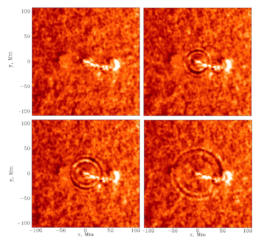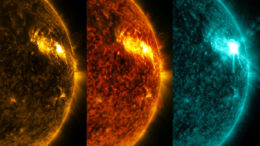A sunquake might sound like something that would be pitted against a tsunami in a B-level disaster movie, but these ripples on the Sun’s surface aren’t likely to affect us here on Earth. Instead, astronomers study sunquakes to understand their connection to another important solar phenomenon: solar flares.
Disturbances on the Solar Surface

Sunquakes appear as expanding circular wavefronts in Doppler images. The event shown here was the first flare-generated sunquake ever detected. [ESA/NASA SOHO]
Somehow, solar flares power these massive seismic events, but the exact mechanism isn’t known. So far, the majority of sunquakes have been observed in the photosphere, but recent observations suggest they also occur in the chromosphere, the region above the photosphere where the temperature begins to rise. One key to understanding these events is to pin down where they occur, leading Sean Quinn (Queen’s University Belfast, Ireland) and collaborators to seek them out.
Snapshots of the Sun
Quinn and coauthors began their search with a set of 62 sunquakes that had previously been discovered in pictures of the solar photosphere. Their goal was to find evidence of these same sunquakes in 160- and 170-nm ultraviolet images from the Solar Dynamics Observatory (SDO) Atmospheric Imaging Assembly, which probe higher temperatures — and therefore higher altitudes — than the photospheric images.

An example of a sunquake wavefront (indicated by the red arrow) in a 170-nm image from SDO. [Adapted from Quinn et al. 2021]
Because the SDO ultraviolet images capture photons from a range of altitudes, it’s challenging to discern the exact location of these sunquakes. However, previous analysis of SDO images found that flare-associated 160- and 170-nm emission arises from the chromosphere. This suggests that the nine sunquakes studied in this article also occurred in the chromosphere and can be used as a starting point for future studies.
The Investigation Continues

These Solar Dynamics Observatory images of the Sun show a solar flare in three extreme ultraviolet wavelengths. From left to right: 17.1, 30.4, and 13.1 nanometers. [NASA/GSFC/SDO]
Citation
“Flare-induced Sunquake Signatures in the Ultraviolet as Observed by the Atmospheric Imaging Assembly,” Sean Quinn et al 2021 ApJ 920 25. doi:10.3847/1538-4357/ac0139

